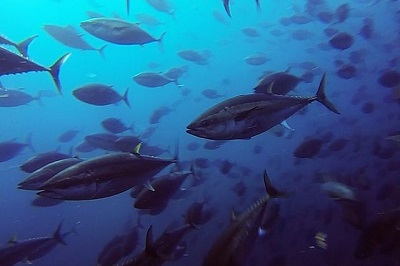Why do our oceans contain such a staggering diversity of fish of so many different sizes, shapes and colors? A team of biologists reports that the answer dates back 66 million years, when a six-mile-wide asteroid crashed to Earth, wiping out the dinosaurs and approximately 75 percent of the world’s animal and plant species, according to Science Daily.
Slightly more than half of today’s fish are “marine fish,” meaning they live in oceans. And most marine fish, including tuna, halibut, grouper, sea horses and mahi-mahi, belong to an extraordinarily diverse group called acanthomorphs.
(The study did not analyze the large numbers of other fish that live in lakes, rivers, streams, ponds and tropical rainforests.)
The aftermath of the asteroid crash created an enormous evolutionary void, providing an opportunity for the marine fish that survived it to greatly diversify.
“Today’s rich biodiversity among marine fish shows the fingerprints of the mass extinction at the end of the Cretaceous period,” said Michael Alfaro, a professor and lead author of the study.
To analyze those fingerprints, the “evolutionary detectives” employed a new genomics research technique developed by one of the authors.
When they studied the timing of the acanthomorphs’ diversification, Alfaro and his colleagues discovered an intriguing pattern: Although there were many other surviving lineages of acanthomorphs, the six most species-rich groups of acanthomorphs today all showed evidence of substantial evolutionary change and proliferation around the time of the mass extinction. Those six groups have gone on to produce almost all of the marine fish diversity that we see today, Alfaro said.
He added that it’s unclear why the other acanthomorph lineages failed to diversify as much after the mass extinction.
“The mass extinction, we argue, provided an evolutionary opportunity for a select few of the surviving acanthomorphs to greatly diversify, and it left a large imprint on the biodiversity of marine fishes today,” Alfaro said. “It’s like there was a lottery 66 million years ago, and these six major acanthomorph groups were the winners.”
The findings also closely match fossil evidence of acanthomorphs’ evolution, which also shows a sharp rise in their anatomical diversity after the extinction.
The genomic technique used in the study, called sequence capture of DNA ultra-conserved elements, was developed by Brant Faircloth, who is now an assistant professor. Where previous methods used just 10 to 20 genes to create an evolutionary history, Faircloth’s approach creates a more complete and accurate picture by using more than 1,000 genetic markers. (The markers include genes and other DNA components, such as parts of the DNA that turn proteins on or off, and cellular components that play a role in regulating genes.)
The researchers also extracted DNA from 118 species of marine fish and conducted a computational analysis to determine the relationships among them. Among their findings: It’s not possible to tell which species are genetically related simply by looking at them. Seahorses, for example, look nothing like goatfish, but the two species are evolutionary cousins — a finding that surprised the scientists.
“We demonstrate this approach works, and that it sheds new light on evolutionary history for the most species-rich group of marine vertebrates,” Alfaro said.
N.H.Kh

